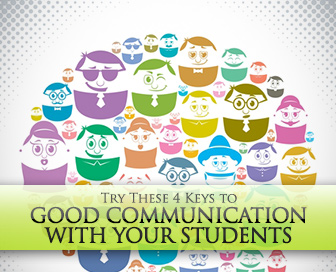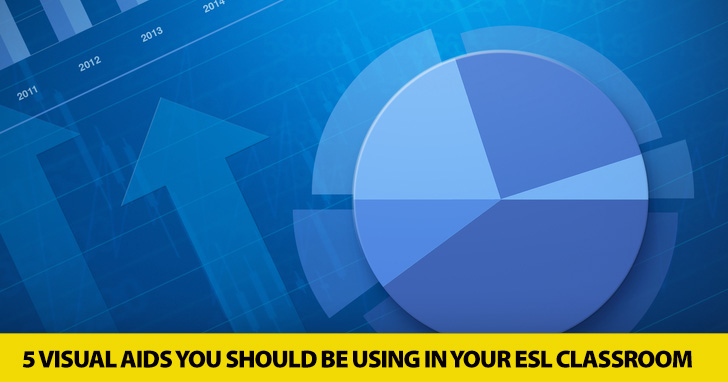4 Keys to Good Communication with Your Students


If a picture is worth a thousand words, including the right visuals for your students to look at can be the avenue to thousands of English words and skills. Plus, visuals bring understanding while bypassing the language centers of the brain, so they are perfect for students who are struggling to achieve fluency in English. Visual aids help students with many learning styles, and they simply make your classroom and your lessons more interesting. But visual aids don’t have to be complicated to be of great value. Here are some visual aids you probably already have on hand or can access without much trouble, and they are ones you will want to have in your class today.

No doubt you’d agree that a picture dictionary is great for beginning level students. In these simple little books, students can see pictures of the vocabulary you are teaching without having to suffer through potentially horrible teacher illustrator skills (like mine). But picture dictionaries are beneficial for intermediate and advanced classes, too. One of my favorite ways to use a picture dictionary is to teach groups of related vocabulary words at the same time. I love being able to show students how English words relate to each other in a meaningful context. When you know what a hit is and bases are, the word homerun has a whole new level of meaning. You can also use picture dictionaries to elicit new vocabulary or see how many words your students are able to produce on their own. Simply cover the list of vocabulary at the bottom of the page and see how many items in the picture your students can identify.
I have found no visual aid more helpful in teaching English verb tenses than time line diagrams. If you use Azar’s Understanding and Using English Grammar to teach, you probably know just what I am talking about. In the beginning of the book are timeline diagrams that illustrate when the different English tenses occur and how to use them. I have reproduced these diagrams in almost every class I have taught. These aren’t the only diagrams that are helpful in ESL classes though I can’t recommend them more highly. You can diagram prepositions of location, vocabulary words that identify pieces of a larger whole (like base and hit), locations on a map, or any number of other topics you might be teaching on. I’m particularly a fan of diagrams because you don’t need any art skills to do them well. Most times a few simple lines are all it takes to show through a diagram what you want your students to learn.
Are you teaching from a text book? More likely than not that book contains pictures. Don’t throw that great resource away. Make sure you take time in class to look at the pictures in your text book and point out to your students the meaning that is illustrated through them. Don’t stop there, though. You can print pictures from the internet on any topic you are teaching your ESL students. Your two best friends for finding pictures to use in class will be an image search and Pinterest. With as little as one key word, these two resources will bring up dozens of pictures you can use in class. Project them in your classroom or print them out and make copies for your students. You can do tons of activities with pictures (matching vocabulary words to their pictures in memory, go fish, or similar games, using pictures to illustrate new vocabulary, have one student describe a picture to another who then draws it, have two students talk about the similarities and differences between two pictures, etc.). When you are done, throw the copies in a file to use next year or recycle them to keep your classroom tidy and green.
Do you want your students to ask and answer simple informational questions? Are you teaching comparative and superlative adjectives? Do you want to give your students an idea of what they will read without giving the whole article away? You should be using charts and graphs. Charts and graphs make great visual aids in the English as a second language classroom because they have so much information packed into such a simple, easy to understand picture. They communicate tons of information through limited use of language and are therefore great for informing your students without running into the language barrier.
Do you have empty wall space in your classroom? Fill it with posters. Posters make great visual aids in the ESL classroom, and you can use them to teach English to your students even when they are checked out in class. Posters don’t have to be fancy or even purchased. You can make your own posters with nothing more than a piece of paper and a marker. The beauty of posters is that they are always visible. When students check out during class or get bored with an activity, they will undoubtedly look around your classroom. If you have posters hanging on your walls, that is what they are going to see. The information will be on display whether your students are trying to learn it or not. And the more they look at that information, the deeper it will ground itself in their language learning systems. Busy teacher has loads of posters you can use to teach without teaching, so don’t hesitate to use that resource to your advantage in your classroom.
The right visual aids can communicate large amounts of information without requiring a large amount of language knowledge. They can elicit ideas from your students and give them something to talk about. They can teach your students when they aren’t paying attention to what you are saying. Most of all, they make your lessons more interesting and engaging. You have potential visual aids all around you. All you have to do is make the most of them in your class.